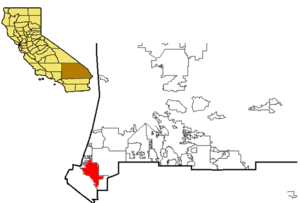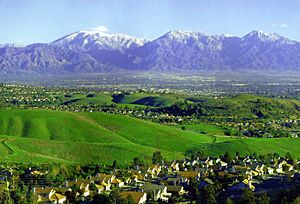Rancho Santa Ana del Chino facts for kids
Rancho Santa Ana del Chino was a very large piece of land, about 22,193 acres (which is about 90 square kilometers). It was a Mexican land grant located in the Chino Hills and southwestern Pomona Valley areas. Today, this land is part of San Bernardino County, California.
The land was given to Antonio Maria Lugo in 1841 by the Mexican Governor of Alta California, Juan Bautista Alvarado. The name "Santa Ana del Chino" means "Saint Anne of the Fair Hair." However, some people believe the ranch was named after a mission foreman who had curly hair, as "chino" can also mean "curly" in Spanish. The cities of Chino, California and Chino Hills, California are now located on this historic rancho land.
Contents
History of the Rancho
How the Rancho Started
In 1841, Antonio Maria Lugo received the rights to Rancho Santa Ana del Chino. This land used to be part of the Mission San Gabriel Arcángel and was used for grazing horses and cattle. The Mexican government took control of mission lands in the 1830s, making them available for private ownership.
Soon after getting the land, Lugo built an adobe house. This house was located where Boys' Republic is today in Chino Hills. Lugo then handed over the management of the ranch to his son-in-law, Isaac Williams. Williams was born in Pennsylvania and had lived in other parts of the United States before coming to California in 1832. He settled in Los Angeles and became a merchant. He married Maria de Jesus Lugo in 1839. After she passed away, Governor Manuel Micheltorena gave Williams even more land, making the rancho even bigger.
While at the Chino ranch, Williams raised thousands of cattle. He sold their hides and fat (tallow) for trade. These products were taken to the harbor at San Pedro Bay.
The Battle of Chino
An important event happened during the American war with Mexican California. This event was called the "Battle of Chino." Isaac Williams and other Americans and Europeans were surrounded by Mexican Californios (people of Spanish or Mexican descent living in California). These Californios were defending their homeland.
One of the leaders of the Californios was Jose del Carmen Lugo, who was Isaac Williams' brother-in-law. He ordered that Williams' house be set on fire to make the people inside surrender. The captured men were then taken to Paredon Blanco (now Boyle Heights) and held there for several weeks. They were later released after promising to act peacefully. A special plaque has been placed near the Boys Republic property in Chino Hills to remember this battle.
California Becomes a State
After the Mexican–American War, California became part of the United States. The original agreement, the Treaty of Guadalupe Hidalgo, said that old land grants would be honored. However, this part was removed later. When the Gold Rush began, many people came to California. Isaac Williams became very wealthy by selling beef to these new arrivals.
But there were also problems with people settling on the land grants without permission. So, in 1851, the U.S. Congress passed a law about land claims in California. A claim for Rancho Santa Ana del Chino was filed in 1853. The grant, including the original 22,193 acres and an additional 13,366 acres, was officially given to Isaac Williams' daughter, Maria Merced Williams de Rains, in 1869.
A Rancho Shootout
After Isaac Williams passed away in 1856, Rancho Santa Ana del Chino was left to his two daughters, Merced Rains and Francisca Carlisle. In 1858, the rancho became one of the stops for the Butterfield Overland Mail stagecoach. Merced and her husband, John, sold their share of the rancho to Francisca and her husband, Robert Carlisle. They then bought a nearby ranch called Rancho Cucamonga.
Robert Carlisle later had a disagreement with the King family. In July 1865, Carlisle was confronted by two of the King brothers in a busy hotel in Los Angeles. A big shootout happened, and Carlisle and one of the King brothers died. The other King brother was injured, and others were hurt too.
Francisca, Robert Carlisle's widow, continued to own the ranch until 1881. Parts of it were rented out, and the rest was managed by Joseph Bridger. Bridger was married to Victoria Regina Williams, who was Isaac Williams' daughter. Joseph Bridger built an adobe house on what is now Los Serranos Country Club in Chino Hills. He worked as the ranch foreman from 1865 until he passed away in 1880.
Francisca Carlisle later married Frederick McDougal, who was a doctor and even the mayor of Los Angeles for a time. She later married again and lived near San Francisco.
New Owners and Big Plans
In 1881, Richard Gird, a miner from Arizona, bought Rancho Santa Ana del Chino. He bought even more land, making his total holdings about 47,000 acres. For many years, Gird used the rancho for raising livestock. In 1887, during a time of rapid growth in the region, he divided about 23,000 acres into smaller ranches. He also set aside 640 acres for the town of Chino.
Gird had many big plans for the Chino area. These included building a sugar beet factory and a railroad. He also helped set up a University of California agricultural station branch. This station later moved to Riverside and became the University of California, Riverside campus we know today. However, a financial downturn in the 1890s greatly affected Gird's plans.
Chino's Growth and Prisons
Rancho Santa Ana del Chino was sold in 1893 and again in 1895 to different groups of investors. By 1900, a new group of business people from San Francisco and Los Angeles bought the ranch. They created a company to reshape the town of Chino and manage the rest of the ranch land. In 1910, Chino officially became a city.
Over the years, more parts of the old ranch were sold. However, major development didn't happen until after World War II. The state bought land to build prisons for men, women, and young people. The Chino Airport was also built on former rancho land. Significant suburban development, with many new homes, didn't really start until the late 1980s. In 1991, the new city of Chino Hills was created from the western part of the old ranch.
Historic Sites of the Rancho
- Pasinogna, California - This was a Tongva Native American village. A person named Hugo Reid mentioned this village in his writings in 1852, but its exact location was not specified.
- Lugo/Williams Adobe - Jose Maria Lugo built a large adobe home on the Rancho in 1841. This home was later lived in by Isaac Williams and his family. The "Battle of Chino" happened here during the Mexican–American War on September 26–27, 1846. During this battle, 24 Americans, led by Benjamin Davis Wilson, were hiding in the adobe house and were captured by about 50 Californios.33°59′24″N 117°43′4″W / 33.99000°N 117.71778°W
- The Joseph Bridger Adobe - This adobe house lasted until the property became Los Serranos Country Club in 1925, but the building was later torn down.33°58′9″N 117°42′2″W / 33.96917°N 117.70056°W



